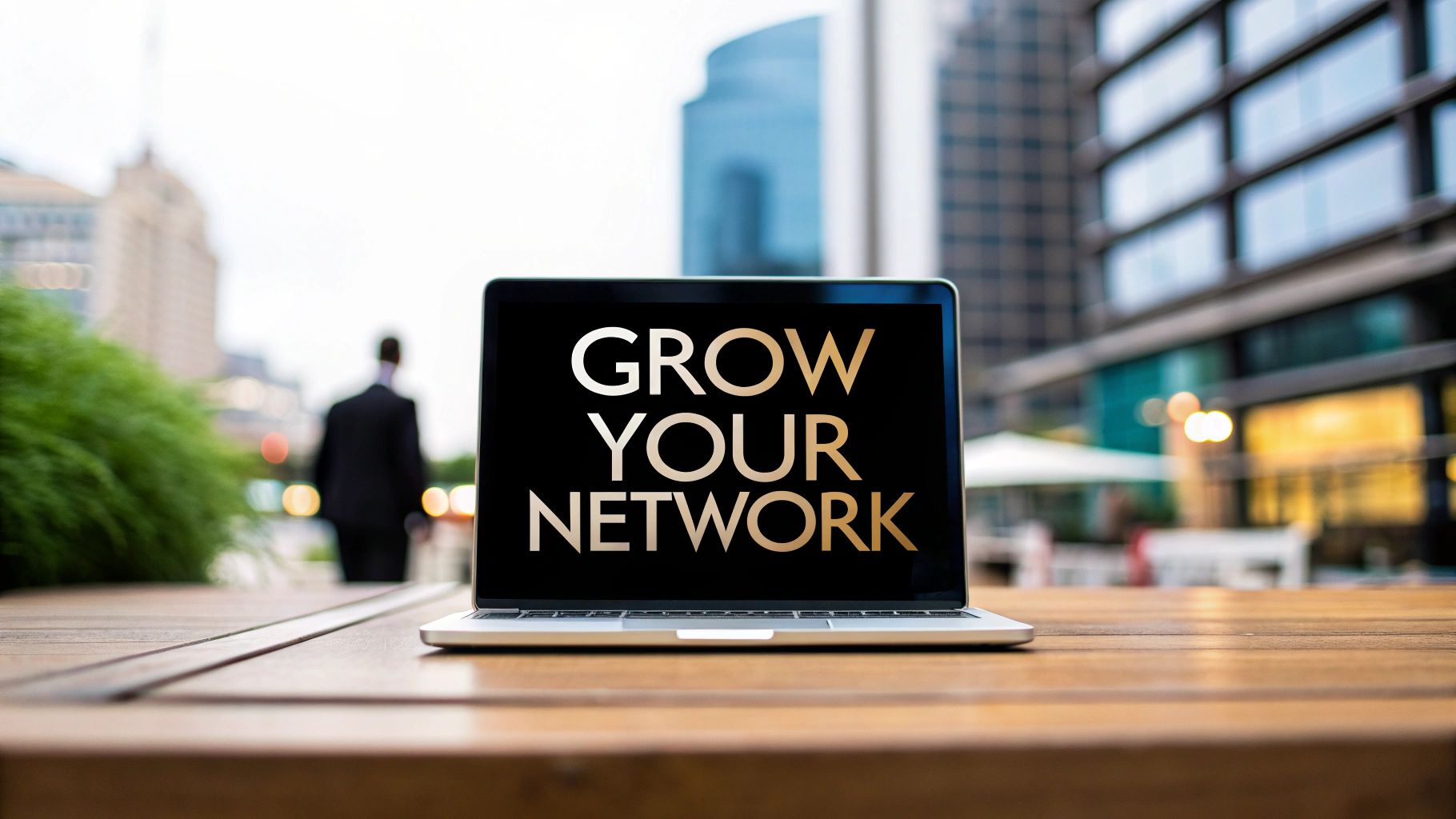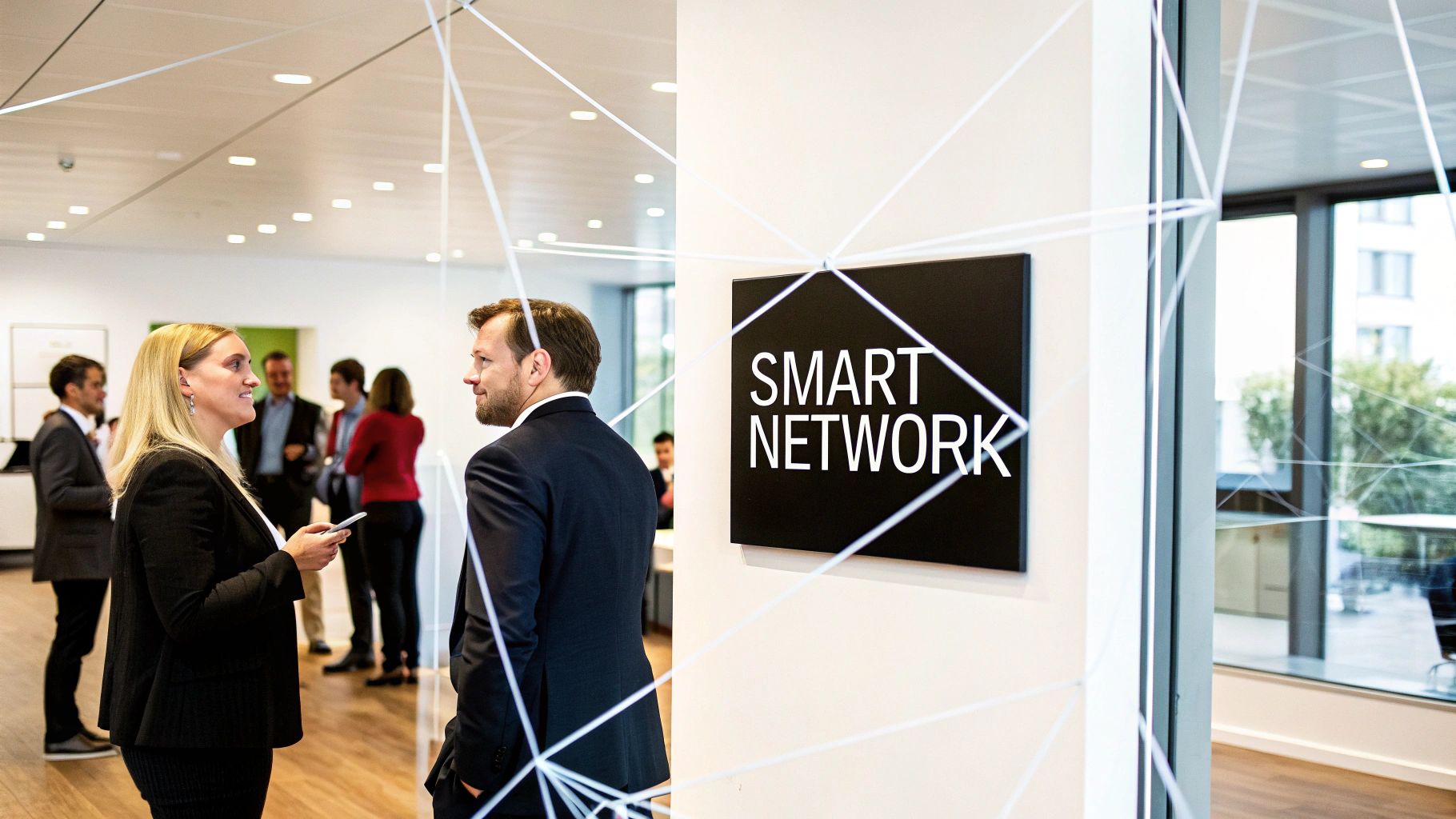
How to Grow LinkedIn Connections: Proven Tips
Published on 2025-04-22
Understanding the LinkedIn Landscape: Who's Really There?

Before sending connection requests, it's essential to understand your target audience on LinkedIn. Just like at a networking event, you wouldn't approach everyone. Instead, you'd strategically target individuals aligned with your professional goals. Understanding LinkedIn's demographics allows you to focus your efforts for more effective connection growth.
Identifying Your Ideal Connections
Knowing who uses LinkedIn, and their usage patterns, is crucial. LinkedIn is a dynamic network of professionals at all career stages, from students and entry-level employees to senior executives. Each group has unique motivations. Recent graduates may be seeking mentorship or entry-level roles, while senior managers could be looking for partnerships or top talent.
This demographic information helps tailor your approach. Connecting with a CEO requires a different message than connecting with a college student. Successful networking hinges on understanding your audience and adapting your communication style accordingly. This includes your profile, connection requests, and overall engagement strategies.
LinkedIn's growth provides a vast pool of potential connections. As of early 2025, LinkedIn surpassed 1.1 billion registered members, an average annual increase of roughly 70 million users. Find more detailed statistics here. That's about three new members joining every second! The 25-34 age group represents a significant 50-60% of users, highlighting this key demographic's importance for connection growth strategies.
To help you visualize this demographic information and its potential impact on your connection strategy, let's take a look at the table below:
LinkedIn User Demographics Breakdown This table provides a detailed breakdown of LinkedIn users by age group and their typical professional status, helping readers target their connection strategies to specific demographics.
| Age Group | Percentage of Users | Typical Professional Status | Connection Growth Opportunity |
|---|---|---|---|
| 18-24 | 10-15% | Students, Entry-Level | High (Open to networking, seeking mentorship) |
| 25-34 | 50-60% | Early to Mid-Career Professionals | Highest (Large user base, actively seeking career advancement) |
| 35-54 | 20-25% | Mid to Senior-Level Professionals, Managers | Moderate (Established networks, selective in connections) |
| 55+ | 5-10% | Senior Executives, Consultants | Moderate (Focused on specific opportunities, value-driven connections) |
As this table clearly demonstrates, understanding the typical professional status of each age group on LinkedIn allows you to craft more effective connection strategies.
Leveraging Demographic Insights
Analyzing demographics pinpoints where your ideal connections are most receptive. Knowing the 25-34 age group is prominent isn't enough. You need to understand their career stage, professional goals, and the content they engage with.
This allows you to create targeted connection requests and engage in meaningful conversations. Instead of generic invitations, personalize your messages by highlighting shared interests or common ground. This approach helps you stand out and increases your chances of building valuable, long-term professional connections.
Geographic Targeting: The Overlooked Connection Multiplier
Many professionals focus on amassing a large number of LinkedIn connections. However, they often overlook a key element: location. Simply having a high connection count isn't enough. Geographic targeting, the practice of focusing your networking on specific regions, can significantly amplify your connection-building efforts.
This strategic approach allows you to tap into specific markets, industries, and talent pools. For example, connecting with professionals in Silicon Valley or Bangalore could be more beneficial for a tech professional than connecting with individuals in less tech-focused areas.
Identifying Key Markets and Regional Norms
Choosing the right location is only half the battle. Understanding regional networking norms is equally important. Different cultures have different approaches to networking. What works in one country may not be effective in another. Researching the dominant industries in your target regions will further refine your connection strategy.
Start by researching the specific regions you're targeting. Uncover the key industries, networking events, and cultural nuances. Some regions may prefer formal communication, while others might favor a more casual approach. Adapting your outreach to these norms is essential for building genuine connections.
Utilizing LinkedIn's Geographic Search Filters
LinkedIn provides powerful tools to refine your searches based on location. You can easily find professionals in specific cities, regions, or countries. This is invaluable for targeting specific markets for potential clients, partners, or collaborators.
Combining geographic targeting with other filters like industry or job title allows for highly focused network expansion. This ensures you connect with people who genuinely align with your professional goals. You're building a network with purpose, not just adding numbers.
Furthermore, understanding the geographic distribution of LinkedIn users provides valuable insights. The United States boasts 250 million registered users, followed by India with 150 million, and Brazil with 81 million. Explore this topic further.
These large user bases offer significant connection opportunities. However, don't discount emerging markets like Indonesia (33 million users) and Mexico (26 million users), where competition might be less intense.
To illustrate the global distribution of LinkedIn users and the potential for connection growth, consider the following table:
Top LinkedIn Markets by User Base
This table compares the largest LinkedIn markets globally, highlighting connection opportunities and regional networking characteristics.
| Country | User Base (Millions) | Growth Rate | Best Industries for Networking | Connection Request Acceptance Rate |
|---|---|---|---|---|
| United States | 250 | Stable | Technology, Finance, Healthcare | Medium |
| India | 150 | High | IT, Manufacturing, Pharmaceuticals | High |
| Brazil | 81 | Moderate | Energy, Agriculture, Services | Medium |
| Indonesia | 33 | High | E-commerce, Manufacturing, Tourism | High |
| Mexico | 26 | Moderate | Manufacturing, Automotive, Tourism | Medium |
Note: Growth Rate and Connection Request Acceptance Rate are illustrative and can vary based on various factors.
As the table shows, focusing on specific geographic regions can significantly impact your networking strategy. By understanding the user base and industry landscape of each region, you can tailor your approach for maximum effectiveness.
Tailoring Connection Requests for Regional Relevance
Identifying your target regions is just the first step. Tailoring your connection requests is crucial for success. Mentioning a local industry event or shared interest related to the region can greatly increase your chances of acceptance.
This personalized touch shows genuine interest and sets your request apart from generic invitations. It demonstrates that you're not just randomly adding connections, but strategically building a relevant network.
Managing Time Zone Differences and Cross-Border Networking
Building a global network often involves navigating time zone differences. Schedule your communication strategically to maximize visibility and responsiveness. Tools for scheduling posts and messages can be invaluable.
Consider joining LinkedIn groups focused on international business or specific regions. These groups provide excellent platforms for connecting with professionals across borders and learning about different market dynamics.
Transform Your Profile Into a Connection Magnet

Your LinkedIn profile is more than just an online resume. It's the foundation of your networking efforts, the first impression you make on potential connections. It's the deciding factor that draws people in or pushes them away. By studying successful LinkedIn profiles, we can pinpoint the essential elements that organically attract connection requests.
Crafting a Compelling Headline and Summary
Your headline is the first thing people notice in search results, so make it impactful. Don't simply state your current job title; showcase your unique value. Instead of "Marketing Manager," consider something like "Marketing Manager | Driving Growth Through Data-Driven Strategies." This clearly communicates your skills and attracts people interested in similar fields.
Your summary offers a chance to go beyond a simple resume recap. Use it to tell your professional story, highlighting your passions, accomplishments, and goals. Think of it as a concise and engaging elevator pitch, focusing on the value you bring.
Showcasing Your Experience and Skills
The experience section is where you validate your claims. Don't just list your responsibilities; highlight your achievements and the impact you made in each role. Use quantifiable data and metrics whenever possible to demonstrate your success. For example, instead of "Increased sales," write "Increased sales by 15% in Q2 2024."
Your skills section plays a crucial role as well. Endorse skills relevant to your target audience, and reciprocate endorsements with colleagues. This social proof builds credibility and improves your visibility in relevant searches.
The Power of a Professional Photo
Your profile picture is the visual anchor of your profile. A professional, high-quality headshot where you appear approachable and confident is key. Studies show that profiles with professional photos receive significantly more views and connection requests. A warm smile and appropriate attire can have a significant impact.
Optimizing for LinkedIn's Algorithm
LinkedIn's algorithm favors complete and active profiles. Ensure all sections are filled out, and regularly update your profile with new skills, experiences, and endorsements. Sharing valuable content and engaging in relevant groups signals your active status, increasing your visibility to potential connections. Learn more in our article about How to Master Your Personal Brand on LinkedIn.
By optimizing your profile for both people and the algorithm, you create a connection magnet that consistently works for you, attracting relevant connections without constant manual outreach. This attention to detail transforms your profile from a static document to a dynamic networking tool. By implementing these strategies, you can boost your visibility and attract valuable connections aligned with your career goals.
Strategic Engagement: The Catalyst for Natural Connection Growth
Sending connection requests is just the first step. True network growth on LinkedIn blossoms from strategic engagement. Think of it as a real-world networking event. You wouldn't simply hand out business cards and leave. You'd engage in conversations, learn about others, and share your own insights. This is how you translate that real-world dynamic to LinkedIn.
The Power of Active Participation
What truly puts you on the radar of potential connections? It's active participation. Liking posts shows you’re present, but commenting elevates the interaction. Thoughtful comments, offering insights or asking relevant questions, demonstrate genuine interest and can spark conversations.
This engagement shouldn't feel forced. It’s about contributing value and building relationships, not generic praise. Instead of "Great post!", try something like, "This insight about [topic] is relevant to my work in [area]. I’m curious about [specific question]."
Content Strategy: Sharing Vs. Creating
Sharing relevant content from others positions you as a valuable resource. Creating original content, however, establishes your expertise and thought leadership. This doesn’t require lengthy articles. A quick observation about industry trends, a personal anecdote, or a thought-provoking question can generate engagement.
For a deeper dive into content creation, check out this guide: How to Master Your LinkedIn Content Strategy.
Understanding the Algorithm and Engagement Frequency
LinkedIn’s algorithm rewards consistent, meaningful engagement. The optimal frequency isn’t about constant activity, but maintaining visibility without seeming overeager. Think consistent, measured actions for steady growth.
User activity metrics offer valuable insights. In 2025, LinkedIn had approximately 1.77 billion monthly visits, with around 25% of users interacting with brand content daily. Users spend an average of 48 hours per month on the platform via mobile. Find more detailed statistics here. This data emphasizes the importance of a regular presence.
Initiating Meaningful Conversations and Connecting With Leaders
Strategic engagement provides a natural way to connect with industry leaders. By thoughtfully engaging with their content, you demonstrate genuine interest, providing context for connection. Instead of a cold request, personalize your message by referencing a recent comment thread or shared perspective.
For additional insights into crafting engaging content, you might find this helpful: How to Master Your LinkedIn Content for Growth.
Balancing Personal and Professional Interaction
While LinkedIn is primarily professional, injecting personality makes you more relatable. Sharing a relevant anecdote or commenting on a non-work-related post from a potential connection can build rapport. Successful networkers understand this balance. They view LinkedIn not just for professional advancement, but for building genuine relationships based on shared interests and mutual respect. This approach fosters organic connection growth.
Crafting Connection Requests People Actually Accept

Generic connection requests often get lost in the shuffle. To effectively expand your network on LinkedIn, you need to create requests that truly resonate with the recipient. This involves understanding effective communication and personalizing your approach.
Researching Your Prospects: The Foundation of a Strong Connection
Before clicking that "Connect" button, take some time to research the person you're targeting. Explore their profile, paying attention to their experience, interests, and shared connections. This background information provides valuable context for a personalized message. Just like at a networking event, personalization is key on LinkedIn.
Identifying Shared Interests and Common Ground
Finding common ground creates an instant connection. Mentioning a mutual contact, a shared alma mater, or a common professional interest shows you've done your homework. This personal touch significantly increases your chances of a successful connection. For example, mentioning you attended the same university can establish immediate rapport.
Crafting Personalized Messages That Showcase Value
Your connection request should clearly and concisely communicate your value proposition. Why should someone connect with you? Avoid overly promotional language. Instead, focus on shared professional goals or mutual interests. Highlight how your skills and experience align with their interests, or how a connection could be mutually beneficial.
The Optimal Length and Follow-Up Strategy
Brevity is key. A few well-crafted sentences are far more effective than a long, rambling paragraph. If you don't hear back, a polite follow-up a week later is acceptable, but don't be persistent. This shows genuine interest without being overbearing.
Cold Connections vs. Warm Introductions: Tailoring Your Approach
Cold connections and warm introductions require different strategies. For cold connections, clearly explain why you're reaching out and the value you bring. With a warm introduction, mention the mutual connection and the context of your introduction. This facilitates a smoother, more natural connection.
Template Examples and Performance Data
Here are a few examples of effective connection requests:
- Cold Connection: "Hi [Name], I came across your profile while researching [industry/topic]. Your experience in [area] aligns with my work in [area]. I'd love to connect and learn more about your insights."
- Warm Introduction: "Hi [Name], [Mutual Connection] suggested I connect with you. I'm also working on [project/area] and would appreciate the opportunity to discuss your experience."
By analyzing the performance of different connection request elements, you can refine your approach over time. This ongoing optimization is crucial for consistently growing your LinkedIn network.
Leveraging LinkedIn Groups for Strategic Network Expansion
While many professionals focus on direct outreach, LinkedIn Groups offer a powerful, often underutilized avenue for expanding your network. These groups function as niche online communities where professionals connect, share insights, and cultivate relationships. By strategically engaging in relevant groups, you can organically grow your network with like-minded individuals.
Identifying and Joining the Right Groups
Finding the right groups is paramount. Search for groups related to your industry, target audience, or professional interests. For instance, if you're in marketing, consider joining groups focused on digital marketing, content strategy, or social media marketing. This targeted approach ensures you connect with people aligned with your career goals. For better engagement within these groups, you might find this resource helpful: How to Master LinkedIn Content Ideas.
Establishing Yourself as a Valuable Member
Simply joining groups isn't enough. Active participation is essential. Contribute meaningfully to discussions, share insightful comments, and offer helpful advice. This showcases your expertise and establishes you as a thought leader within the community.
Identifying Influential Group Participants
Certain members hold more sway within each group. These individuals are often highly active, respected for their knowledge and contributions. Connecting with these influencers can significantly broaden your reach and unlock new opportunities. Prioritize engaging with their comments and participating in discussions they initiate.
Sparking Engaging Discussions and Showcasing Expertise
Initiating meaningful conversations can highlight your expertise and attract potential connections. Ask thought-provoking questions, share relevant articles, and offer unique perspectives. This proactive approach positions you as a valuable resource and boosts your visibility.
Transitioning From Group Interactions to Direct Connections
Once you've established a presence within a group, transitioning to direct connections becomes more seamless. When sending a connection request, personalize your message by mentioning a recent group interaction or shared interest. This shows genuine interest and improves your chances of acceptance. Avoid generic connection requests.
Common Group Participation Mistakes to Avoid
While active participation is crucial, avoid common pitfalls. Don't excessively self-promote or flood the group with irrelevant content. Focus on providing value, building relationships, and contributing meaningfully. This fosters trust and genuine connections. Also, steer clear of negative or controversial discussions that could harm your professional reputation.
Measuring What Matters: Track and Scale Your Connection Strategy

Growing your LinkedIn connections isn't simply about accumulating contacts; it's about cultivating a network that actively contributes to your career progression. This involves shifting your focus from superficial metrics like total connection count to those that genuinely reflect the quality and impact of your network. Successful networking is about building relationships, not just collecting contacts. This requires a strategic approach informed by data-driven insights.
Beyond Connection Counts: Prioritizing the Right Metrics
While a large number of connections can be advantageous, the quality of those connections holds significantly more weight. Consider key metrics like engagement rates on your posts, the frequency of meaningful conversations, and the tangible opportunities generated from your network. These indicators offer a more accurate assessment of your network's true value. Ask yourself: are your connections interacting with your content? Are they responding to your messages? Are these interactions leading to collaborations, partnerships, or new career prospects? These questions reveal the genuine impact of your networking endeavors.
Setting Realistic Growth Targets and A/B Testing
Your industry and career stage will naturally influence your ideal connection growth rate. A recent graduate, for instance, will likely experience a different growth trajectory than an established executive. Setting SMART goals—Specific, Measurable, Achievable, Relevant, and Time-bound—is crucial. Instead of aiming for a vague increase in connections, set a concrete target, such as "50 relevant connections in the next quarter." This provides a clear benchmark to track your progress. Additionally, A/B testing different connection request messages can help you identify the approaches that resonate most effectively with your target audience, refining your outreach for optimal acceptance rates.
Automating Without Sacrificing Personalization
Various tools can help automate aspects of your connection strategy, such as scheduling posts and sending follow-up messages. However, maintaining a personal touch remains essential. Generic, automated messages can be counterproductive. Use automation strategically to streamline tasks, but always personalize your communication to maximize impact. A connection request that mentions your specific work or a shared contact demonstrates genuine interest and makes a lasting impression.
Auditing and Leveraging Your Network
Regularly audit your connections to ensure they remain relevant. As your career evolves, so should your network. Removing inactive or irrelevant connections keeps your network focused and dynamic. Furthermore, strategically leverage your first-degree connections to gain access to valuable second-degree prospects. Requesting introductions or referrals can significantly expand your reach within target companies or industries. View your network as a dynamic web of interconnected opportunities, with each connection acting as a potential gateway to a broader circle of professionals.
By focusing on these strategic metrics and approaches, you can cultivate a LinkedIn network that genuinely contributes to your professional success. Remember, it's not about the quantity of connections, but the quality and the opportunities they generate.
Ready to enhance your LinkedIn presence and maximize your network's potential? autoghostwriter helps you create compelling content that fosters connections and drives results. Explore autoghostwriter today and elevate your LinkedIn game.